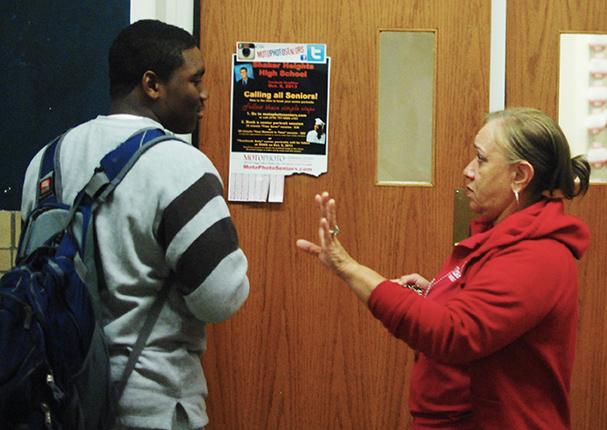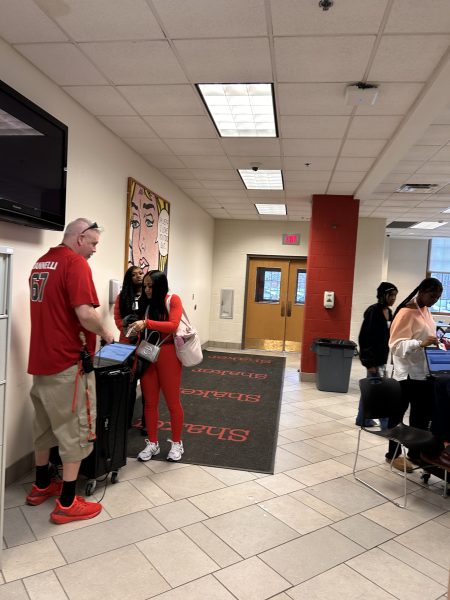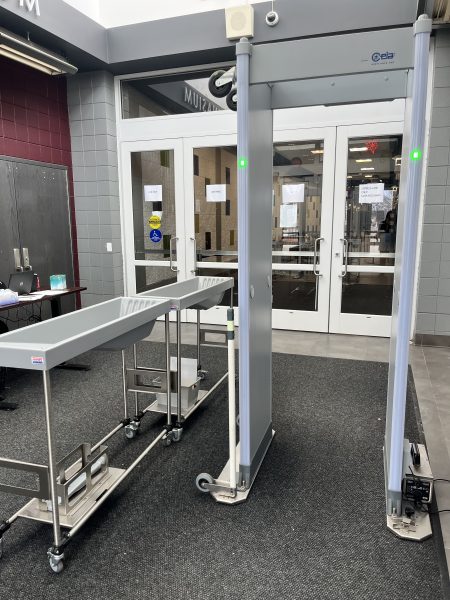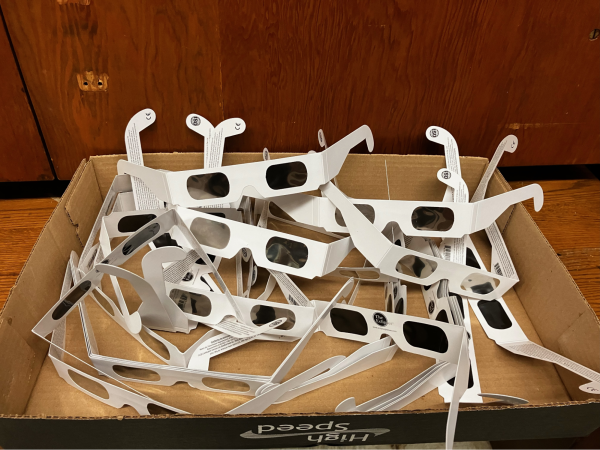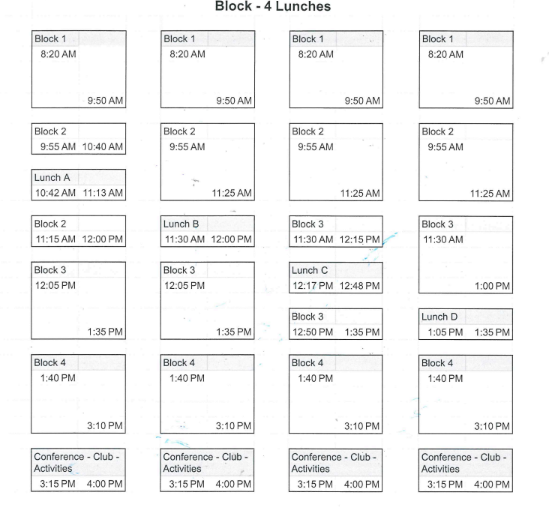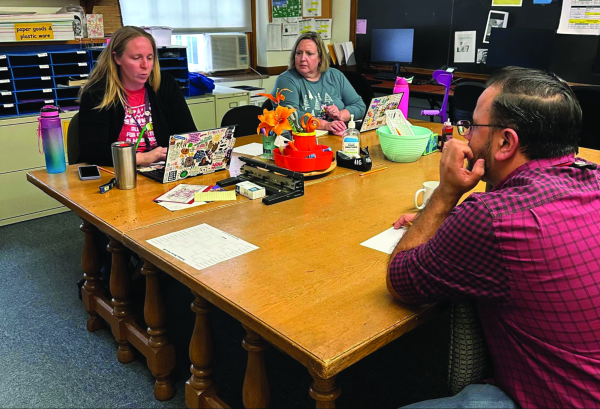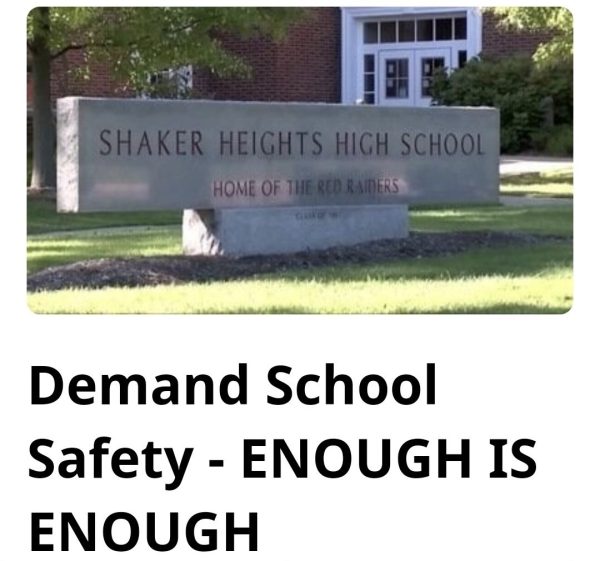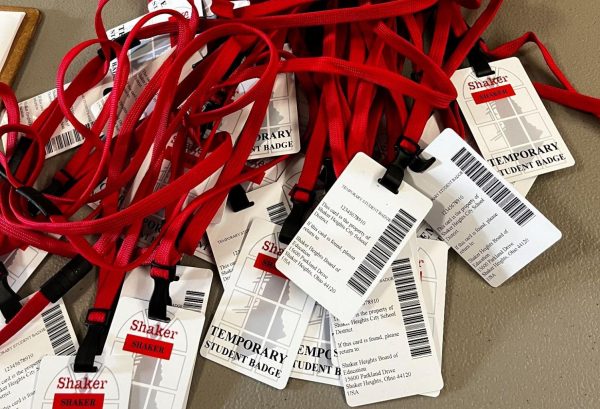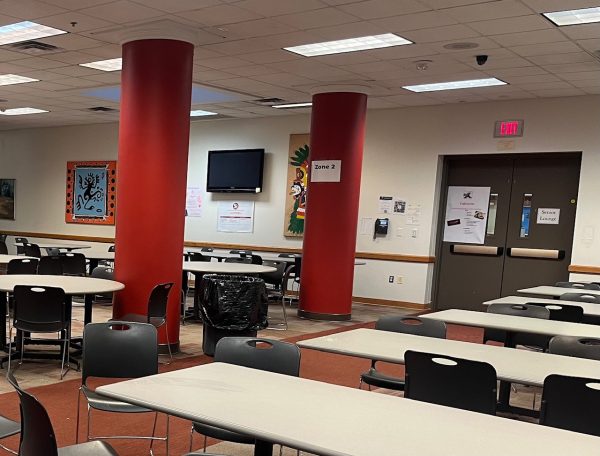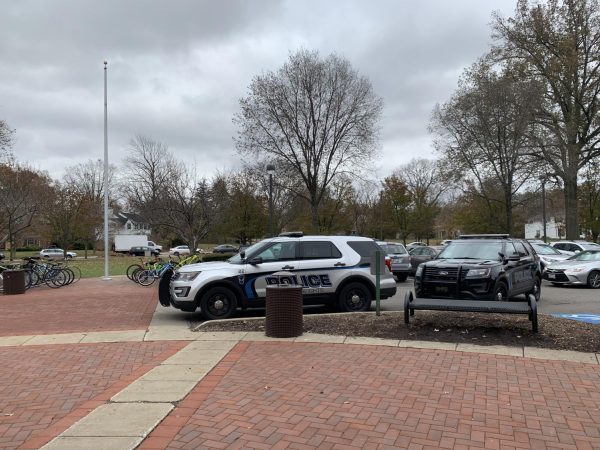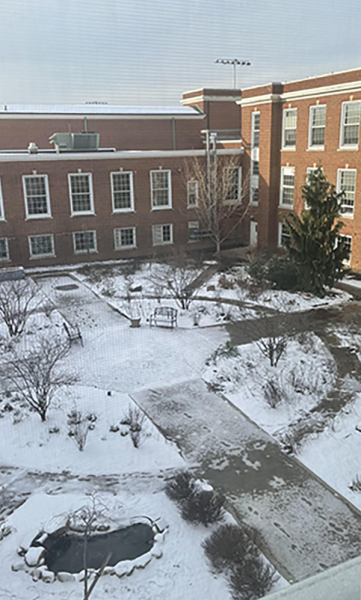Sticking to the Rules, Old and New
High school aims to improve student safety after alleged rape on campus
Security guard Linda Copeland stops a student from entering the Upper Cafeteria Oct. 7 at 3:20 p.m. Superintendent Gregory C. Hutchings said that the district and school are working on determining “vulnerable areas” that need more attention from security personnel.
In a Sept. 12 email to district families and staff members two days after the alleged rape of a female student by a male student at the high school, Superintendent Gregory C. Hutchings, Jr. wrote that senior staff had “initiated a thorough review of security procedures to determine how we can improve supervision in the building. Additional measures are being put into place, with more to come.”
In an interview the next day, Hutchings said, “I don’t know if we’re going to change any of our former practices. I think we’re going to add some additional measures. We want to keep some of the practices we’ve had in place. They were good practices, they’ve got us this far without having a major incident.”
The first-year superintendent said initial additional measures include “having our security officers more visible in the hallways, making sure that areas that are vulnerable areas of our building, and what I mean by that, areas that are unsupervised, that we have locks on doors, and that it’s not easily accessible by students during the school day,” Hutchings said.
In a Sept. 19 email to faculty, Principal Michael Griffith said the high school was “in the process of reviewing all security procedures and use of personnel throughout the day, in order to improve safety.”
Griffith wrote that the review process began when the district formed “a committee to hold an internal assessment of facility needs” in the spring.
In an email interview, district Director of Communications Peggy Caldwell said this committee was established as a “time-limited working group” by retired superintendent Mark Freeman after the Newtown, Conn. school shooting in Dec. 2012.
However, Griffith said in an interview that the Sept. 10 incident expedited the process. “There’s no doubt that the incident creates greater urgency,” he said. “There’s no two ways about that, that any kind of incident that would occur would cause us to push the timetables faster on things.”
Security Presence
Griffith wrote in his email that teachers “should immediately see increased visibility of security throughout the building.” He said that the school hadn’t hired any new security guards, but “restructured work schedules, balanced the lunch schedules of staff and redesigned the zones that security cover during school hours.”
Griffith later said that the district had hired two new security guards to substitute in any school when needed.
Griffith said the school is in the process of altering security guard “patterns of movement and where we want people to roam. We might have had certain people that were stationary, in a spot. So we looked at certain things like, ‘Well, do we want to adjust things where somebody roams more and have fewer stationary spots, so their visibility is greater?’”
High School Safety and Security Coordinator Victor Ferrell said security guards should stay in their designated areas more than they have in the past. “We’re trying to keep them checking off on each other. We get called off a lot. You know, a teacher says, ‘I gotta go to the restroom, can you cover my classroom?’ ‘Can you take this kid here?’ ‘Can a kid go there?’ So they get called off their zones a lot, which is not good, but is also helpful to the teacher.
“We’re trying to keep someone in the hall all the time, which is not always easy, but we’re trying to do that. We want to keep people visible out there more,” Ferrell said.
Griffith said, “We’ve already had some staff members commenting on visibility because people are moving. There are technological tools that can help us with that, where you can track where movement has happened, things of that nature. We don’t have all of that in play in the daytime yet, but we’re looking at things like that.”
Griffith said that the highest security presence during a typical school day consists of 14 staff members, including two off-duty police officers. Most nights there are three or four security staff members at the school, according to Griffith.
Griffith said that he is also re-evaluating the size of the areas that security guards monitor. “Did we have reasonable zones? In other words, was there too much for a person to cover, and are they moving so far away that their ability to really be visible in a space we’re concerned about is diminished?”
“We’re looking at things like that, that weren’t horrible, but do limit how good we can be,” Griffith said.
Hutchings said that in the wake of the Sept. 10 incident the district and school have consulted retired and current Shaker Heights police officers who work at the school. He said they have helped them determine that certain parts of the school “might be classified as vulnerable areas because there isn’t a camera there or because there isn’t a security officer standing at the end of the hallway.”
Open Campus
Hutchings said district and high school administrators are also “looking at how students move throughout the building throughout the day. Today [Sept. 13] when I was over at the school, I saw a number of kids in the halls without passes. I see students who are supposedly in a free period and they’re just wherever they want to be and throughout the building and they’re unsupervised.
“I like the open campus, I guess, idea,” Hutchings said. “I think that it’s given students responsibility and it’s allowing them to make some choices throughout the day about what they want to do with their time. What I think we need to do a better job of is having an accountability system in regard to this open campus.”
He continued, “We’re trying to figure out, ‘OK, how are we going to hold students accountable, still give them the flexibility, still give them the open campus feel, but just a little bit more monitoring and accountability?’”
In a second interview, in early October, Hutchings said, “We’re still going to have an open campus, we’re just going to have locations where they [juniors and seniors with free periods] exit. We’re working on exactly what the accountability system will be, but we want to have a way to kind of document who leaves the building, just to keep on record so that if there ever is an emergency, we would know who’s not in the building, what time they left the building, and that type of thing.”
Currently upperclassmen are permitted to leave the building without signing out during free periods. Hutchings said that Griffith, Ferrell, Assistant Superintendent Marla Robinson, and district Security Supervisor Mike Gale are still discussing this policy shift.
Hypothetically, “there will be somebody or a device at each door that students are able to exit from during the day,” Hutchings said.
Hutchings said that he doubts the open campus culture will change significantly. “We want kids to have freedom and that type of thing, but we need to have more accountability on who’s in the building and who’s not in the building.”
Hutchings said that students, teachers, and administrators have told him that students often leave school when they’re supposed to be in class. He said that he hopes requiring signing out will “decrease the number of students that are leaving the building who shouldn’t be leaving the building.
“I think this is a part of providing a safe learning environment while still allowing students to have some freedom with the open campus,” he said.
“Students who are leaving the building may be ninth or tenth graders and we have no way of even knowing if they’re gone,” Hutchings said. “They never receive a consequence for skipping class. Now if we put a system in place, at least we would be able to discover who shouldn’t be leaving.”
Hutchings said that students could have to meet requirements for leaving school during free periods. “What we need to begin to have discussions on is ‘who’s able or who’s capable of handling that responsibility?’ I don’t believe in punishing all for a small percentage of kids,” he said.
Hutchings continued, “Some of the discussion is having conversations around the students who are not performing academically. Why should they leave the building? They need to be in school during school hours. I think it needs to be more of a privilege for students to leave.”
Hutchings cited the current policy that students are to stay in supervised areas during lunch time and free periods when they opt to stay in the building as an example of a practice that is being poorly enforced.
“What I’m trying to get us to do is follow the things that we already have in place, not reinvent the wheel. And what I think that we’ve done is, we have a lot of policies in place that people just don’t know about because we just don’t follow them. Our practice is to not really review it or enforce it,” Hutchings said.
He declined to comment on whether the suspect or victim were supposed to be in class at the time of the Sept. 10 incident.
In a Sept. 23 interview, Griffith said that he and Hutchings hadn’t discussed curbing the movement of seniors during their free periods.
“I still expect us to be an open campus in the way that we’ve been that way. I think that that’s not necessary to control that to that degree. A student has a choice. You [seniors] should be able to say, ‘I need to talk to my counselor,’ if I have that time. . .Personally I think that would be a huge loss of teaching a level of responsibility.”
Ferrell agreed with Griffith. “Safety is definitely a major issue, but at the same time, so is learning and developing the person to be responsible. I think the way that it’s laid out now is good, where ninth graders and tenth graders are not allowed to leave. The campus is not open for them,” he said. “A senior who will be going on to college, they need to understand that they have that responsibility, that it’s going to be that way in college, you’re going to have to learn how to manage your time and get back on time.
“I’m not necessarily one that believes in locking it down like a prison, and everyone has to be here, and no one can get out, because yeah, you can make it that kind of safe, but I think in that you also lose some of the liberties of learning. And part of learning is a little bit of feeling the world that we live in. There’s always going to be some safety issues involved in that,” Ferrell said.
Entering and Exiting
Griffith’s faculty email also included new restrictions to the time that facility doors open in the morning.
Previously, all doors were open for teacher entrance at 5:30 a.m. Griffith wrote that only three doorways will be open before 6:30 a.m. for teachers, all three of which will require identification card swiping. “We don’t need 20 some odd doors open at 5:30, I mean all of those doors were open at 5:30, including the stadium doors and everything. To me, that’s just not reasonable,” Griffith said during the interview.
At 6:30 a.m. the front entrance door will be open for all, with a security guard posted. At 7 a.m., Griffith wrote, the front hallway doors, Large Auditorium doors, and Aldersyde Road doors will be open “for free access.”
At 8:15 a.m., all doors will be locked. Students will need to enter through the front entrance door while teachers will need to use their swipe cards as they would before 6:30 a.m. Griffith said that doors were previously locked at 9 a.m.
Griffith said that the school will consider security procedure changes for after school. “I think with the issue of the afternoon, we’ve got to work out a much stronger and better methodology from dismissal on. It’s extremely challenging. There’s just so many groups, and clubs, and people, and teams, and there’s a program, and there’s this, and that. We need some pretty serious reflection about how to keep us tighter than we are,” he said.
“We’ve got a lot of people just wandering and loitering that aren’t going to a conference. It has the potential to be disruptive,” Griffith said. “We’re trying to still really be in a school session until 4 o’clock, really. Truth is, students should be able to go and be with a teacher with a door open and have focused time and not have disruptions in the hallways or noise.”
Griffith added that the school is examining ways of encouraging groups of students who are not interested in staying for conferences to leave the school and not re-enter later.
Additional Changes
In an Oct. 11 mailed letter to parents, Griffith provided information about security guard movement and the new door unlocking schedule, as he had emailed to teachers roughly a month before. However, Griffith included two developments that weren’t included in his communication to faculty members.
He wrote that he has restructured security coverage of the gymnasium and locker room areas between 3 p.m. and 8 p.m. “so that access throughout the facility is monitored during practice times.” Griffith also wrote in his parent letter that he is meeting with Ferrell weekly “to review and monitor the progress of these [security personnel movement and door unlocking] changes.”
During his interview, Griffith noted that there will likely be more safety and security procedure revisions throughout the school year.
Ferrell said that this year his department is trying a new security software system and putting cameras in the cafeteria to monitor the lunch line. He added that in the aftermath of the Sept. 10 incident, his staff is changing locks on some doors, double checking that doors are locked when they should be, and making sure doors are fitting properly and closing all the way.
“When these things happen, you are obligated to look at what’s going on. And that’s what we did,” Ferrell said.
“There’ll be other changes that no one will know or need to know about that have to do with how we function in terms of providing safety in the building, that have no visible impact. Where people go, what people look for, that type of thing, because we’re aware of where pockets of concern are,” Griffith said.
Despite their difference in opinion regarding how much freedom seniors with free periods should have, Griffith was pleased with Hutchings’ efforts security-wise in general.
“He has very high expectations, and safety and security is among his top priorities,” Griffith said. “Anytime you have someone new, if at the very least he’s asking lots of questions because he’s seeking understanding of what has been. . .It’s going to cause us to start to reflect on whether it’s the way it should be and if it’s as good as it could be. And that means there’s a good likelihood of change.
“Change in the leadership generally also is going to result in change in practices, not because there are demands for change in practices, but because you’re going to ask all these questions that maybe weren’t asked in the past few years,” he said.
Hutchings’ Role
Hutchings visited the high school frequently in the days following the incident. “I’ve been in meetings. I also just wanted to see for myself if the day was still normal,” he said. “I think that you can only get the evidence and information to make really informed decisions by actually being in the school, seeing it for myself.
During his administrative career, Hutchings has responded to students bringing guns to school, gang violence, and a gang-related student death.
“I don’t think that anybody should feel unsafe in schools,” he said. “I think that wherever we are, young men and women, we need to make sure that we’re being mindful of our surroundings and people that we associate ourselves with.”
Hutchings said Robinson returned “a number” of phone calls to parents concerned about the safety of their children in the days after the incident.
However, when Hutchings attended the high school open house Sept. 12 he said, “not one person came up to me to say that they felt that their child was unsafe or that they wanted their child to be taken out of the school.”
Hutchings concluded, “Our building safety has always been and will always be at the top of my priority list.”
This story appeared in Volume 84, Issue 2 (October 2013) of The Shakerite on pages 4, 5 and 6.
—
For The Shakerite’s previous coverage of the alleged rape, click here.
Learn what SHHS parents are saying about this story here.

